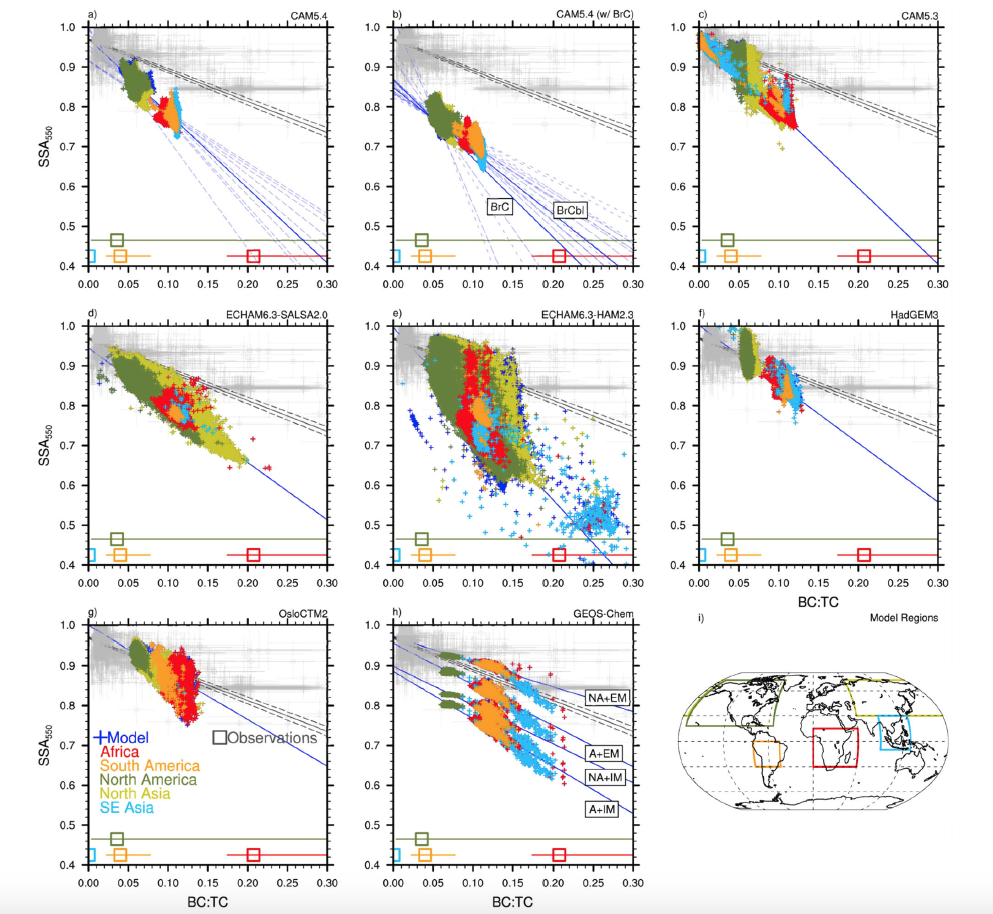Biomass Burning Aerosols in Most Climate Models are Too Absorbing

Smoke from forest fires in wetter climates such as Oregon tends to be brighter and have more of a cooling effect on the climate.
The Science
Biomass burning (BB) aerosols – consisting of a combination of strongly scattering (cooling) and strongly absorbing (warming) species – impact regional and global climate by perturbing the Earth’s energy balance. Earth system and chemical transport models (ESMs/CTMs) struggle to represent the climate impacts of these particles due in part to challenges in simulating aerosol size, composition, and mixing state. These radiative and microphysical properties vary strongly with different fuel types and burning conditions, and ESMs/CTMs can benefit from observations of these aerosols that cover a large range in BB sources. This study addresses the model uncertainty in simulating BB optical properties by comparing nine state-of-the-art ESMs/CTMs to a variety of regional BB observations collected around the globe. In addition, this study quantifies the radiative impacts of model improvements to BB aerosol properties in version 1 of the Community Earth System Model (CESM1).
The Impact
This study presents clear evidence that many ESMs/CTMs simulate BB aerosols that absorb visible light more strongly than observed wildfire smoke. This has implications for simulated BB climate impacts, which may overestimate the atmospheric warming of BB aerosols. The biggest factor in this overestimation is the treatment of BB aerosol mixing state in the models. A correction in this systematic overestimation in absorption could impact assessments such as the Intergovernmental Panel on Climate Change (IPCC) and Phase 6 of the Coupled Model Intercomparison Project (CMIP6) by shifting the currently estimated radiative impacts of BB aerosol towards more negative values. Therefore, this study may have an important implication for the future assessment of BB aerosol radiative effects from the IPCC.

Figure 1. Comparison of observed (in gray) and modeled biomass burning single scattering albedo (SSA) versus black carbon (BC) to total carbon (TC) ratio. The best-fit to the model data is represented by the solid blue line. The model data is from (a) this study (Brown et al. (2021)), (b) Brown et al. (2018) with Brown carbon (BrC), (c-g) AeroCom Phase-III simulations, and (h) Saleh et al. (2015). Model data is representative of BB influenced regions which are color coded in the model output and are specified on the global plot in panel (i). Observational data from the specific regions are averaged, and the regional average and range of the BC:TC observational data is included at the bottom of the plot (color coded squares). For a more detailed caption, see Brown et al. (2021) Figure 2.
Summary
This work compiles observations of aerosol scattering relative to extinction and carbonaceous aerosol composition from 12 different field campaigns and laboratory measurements of BB smoke. Next, nine state-of-the-art ESMs/CTMs are compared to these observations (Fig. 1). From this comparison, it is found that the majority of these models overestimate BB aerosol light absorption compared to observations. The models that have better agreement tend to have less absorbing BB aerosol, larger aerosol sizes, and externally mixed treatments for the species making up BB aerosols. Sensitivity tests are run with CESM1 to test how these microphysical and radiative properties impact model-observational agreement, resulting in model improvement with all of the tested changes. Of these changes, mixing state has the greatest impact on model performance. This study further quantifies the radiative effect of BB aerosol from the different CESM1 sensitivity experiments and finds that these changes result in BB aerosol that have more of a cooling effect in CESM1 than current BB aerosol treatments. Improvements compared to observations in other ESMs/CTMs may lead to similar reductions in the BB radiative effects.
Publication
- Brown, H, X Liu, R Pokhrel, S Murphy, Z Lu, R Saleh, T Mielonen, et al. 2021. “Biomass Burning Aerosols in Most Climate Models are Too Absorbing.” Nature Communications 12(1). https://doi.org/10.1038/s41467-020-20482-9.
Funding
- The U.S. Department of Energy Office of Science, Biological and Environmental Research supported part of this research as part of the Earth System Model Development Program Area through the Enabling Aerosol-cloud interactions at GLobal convection-permitting scalES (EAGLES) project and as part of the Regional and Global Model Analysis Program Area (RGMA).
Contact
- Xiaohong Liu, Texas A&M University


